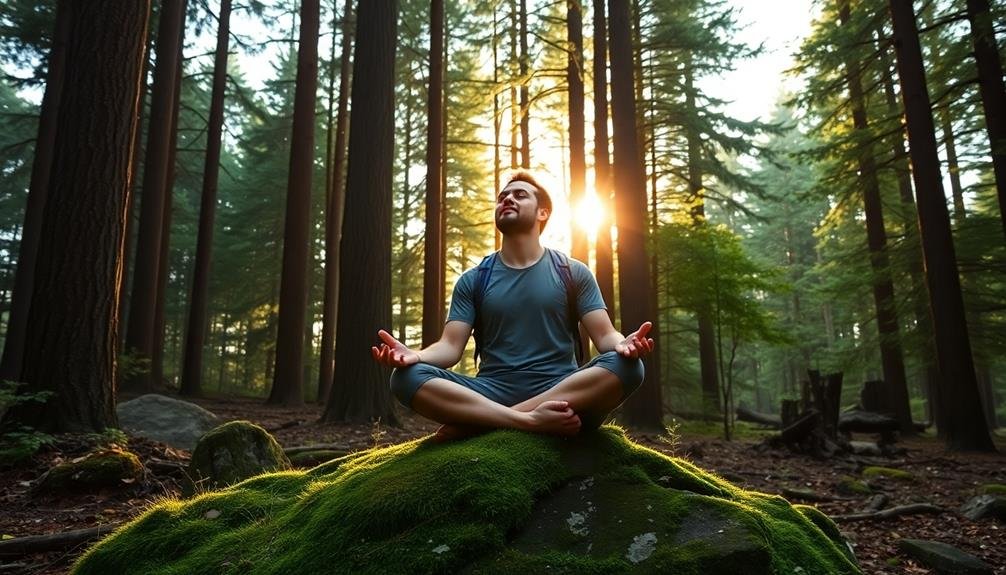Breathing techniques can transform your hiking experience into a calming adventure in nature. Start with diaphragmatic breathing, inhaling through your nose to fill your belly and exhaling slowly through your mouth. Use box breathing to regain focus: inhale, hold, exhale, and pause, each for four counts. Try the 4-7-8 pattern by inhaling for four counts, holding for two, and exhaling for eight. Alternate nostril breathing balances your energy, while mindful breathing synchronizes your breath with your steps. Each technique helps you connect with your surroundings. Keep going to discover even more ways to enhance your hiking serenity.
Diaphragmatic Breathing Technique

Diaphragmatic breathing, often called "belly breathing," can greatly enhance your hiking experience. This technique allows you to fully engage your diaphragm, promoting deeper, more efficient breaths. When you hike, it's easy to fall into shallow, quick breaths, especially if you're tackling steep trails. By practicing diaphragmatic breathing, you'll improve your oxygen intake and reduce fatigue.
To start, find a comfortable position, either sitting or standing. Place one hand on your chest and the other on your belly. Inhale deeply through your nose, allowing your belly to rise while keeping your chest relatively still. Exhale slowly through your mouth, feeling your belly fall. Focus on the rhythm of your breath and aim for a steady pace.
While hiking, integrate this technique by consciously breathing deeply, especially during challenging sections. As you inhale, visualize energy flowing into your body, and as you exhale, let go of any tension or discomfort.
This method not only boosts your stamina but also calms your mind, helping you stay present in nature. By practicing diaphragmatic breathing, you'll find yourself more relaxed and able to enjoy your hiking adventures to the fullest.
Box Breathing Method
When you want to calm your mind and regain focus while hiking, try the Box Breathing method. This technique involves a simple, structured pattern that helps you center your thoughts and regulate your breath.
To start, find a comfortable spot along the trail. Take a deep breath in through your nose for a count of four. As you inhale, visualize filling your lungs completely.
Next, hold your breath for another count of four. This pause allows the oxygen to saturate your body, enhancing your sense of calm.
After holding, exhale slowly through your mouth for four counts, releasing any tension. Finally, pause again for four counts before inhaling once more.
Repeat this cycle several times, focusing entirely on your breath and the rhythm you've established. You'll notice your heart rate slowing and your mind clearing, making it easier to enjoy the beauty around you.
Box Breathing is effective in moments of stress or anxiety, helping you reconnect with nature and yourself. Incorporate this technique into your hiking routine, and you'll find increased serenity and focus on your adventures.
4-7-8 Breathing Pattern

During your hike, you might find the 8 Breathing Pattern to be a powerful tool for enhancing your overall experience. This technique involves inhaling for a count of four, holding your breath for a count of two, and then exhaling for a count of eight. By extending your exhalation, you promote relaxation and help clear your mind, making it easier to connect with nature.
To practice this pattern, find a comfortable pace as you walk. As you inhale through your nose for four counts, visualize filling your lungs completely with fresh, invigorating air. Hold for two counts, allowing that breath to settle.
Then, exhale slowly through your mouth for eight counts, imagining the stress of the day leaving your body with each breath. Repeat this cycle several times.
You'll likely notice that your mind begins to quiet, and your body feels lighter. This method can also help regulate your heart rate, making it particularly useful during challenging sections of your hike.
Alternate Nostril Breathing
Another effective technique to enhance your hiking experience is Alternate Nostril Breathing. This practice not only calms your mind but also balances your energy, making it perfect for tackling challenging trails.
To start, find a comfortable position, either sitting or standing. Use your right thumb to gently close your right nostril. Inhale deeply through your left nostril for a count of four.
Now, close your left nostril with your right ring finger, and release your right nostril. Exhale slowly through your right nostril for a count of four. Inhale through the right nostril for another count of four, then close it again with your thumb. Open your left nostril and exhale for a count of four.
This completes one cycle. Aim to repeat this cycle for five to ten minutes. You'll notice that your breath becomes deeper and more rhythmic, helping you to feel centered and focused.
With each breath, visualize the fresh mountain air filling your lungs, enhancing your overall hiking experience. By incorporating Alternate Nostril Breathing into your routine, you'll promote a sense of calm and clarity, making your adventures even more enjoyable.
Mindful Breathing Practice

Engaging in mindful breathing practice can greatly enhance your hiking experience by grounding you in the present moment. As you trek through nature, take a moment to focus solely on your breath. Inhale deeply through your nose, allowing your belly to expand fully. Hold for a count of four, then exhale slowly through your mouth. This simple technique calms your mind and reduces stress.
As you walk, synchronize your breath with your steps. For instance, inhale for three steps, then exhale for three. This rhythm not only keeps you centered but also helps you connect with your surroundings. Notice the rustling leaves, the scent of pine, and the sound of your breath mingling with nature.
When distractions arise—like fatigue or worries—bring your awareness back to your breath. Acknowledge these thoughts, then let them drift away.
Frequently Asked Questions
How Can Breathing Techniques Improve Hiking Endurance?
Breathing techniques can greatly enhance your hiking endurance. By focusing on deep, controlled breaths, you increase oxygen flow, reduce fatigue, and maintain a steady pace, allowing you to conquer challenging trails with greater ease and enjoyment.
What Are the Benefits of Breathing Exercises for Anxiety During Hikes?
Breathing exercises can greatly reduce your anxiety during hikes. They help calm your mind, improve focus, and enhance your overall enjoyment of nature. You'll feel more present, allowing you to truly appreciate your surroundings.
Can I Practice These Techniques During Other Physical Activities?
Absolutely, you can practice these techniques during any physical activity. They help you stay focused, reduce stress, and enhance your performance. Just incorporate deep breathing into your routine, and you'll feel the benefits.
Are There Any Specific Breathing Techniques for High-Altitude Hiking?
Yes, you can use specific breathing techniques for high-altitude hiking. Focus on deep, slow breaths to maximize oxygen intake, and practice rhythmic inhaling and exhaling to maintain energy and reduce fatigue during your trek.
How Often Should I Practice These Techniques Before Hiking?
You should practice these techniques daily, ideally for at least a few minutes each session. Familiarity builds confidence, helping you adapt better to the challenges of hiking and improving your overall breathing efficiency.
In Summary
Incorporating these breathing techniques into your hiking routine can transform your experience, helping you feel more grounded and connected to nature. Whether you're traversing a challenging trail or simply enjoying a scenic view, using diaphragmatic breathing, box breathing, or any of the methods mentioned will enhance your serenity and focus. Remember, a calm mind leads to a more enjoyable hike. So, take a deep breath, embrace the moment, and let the tranquility of nature inspire you.





Leave a Reply